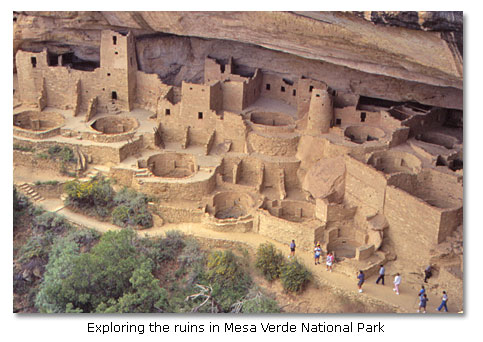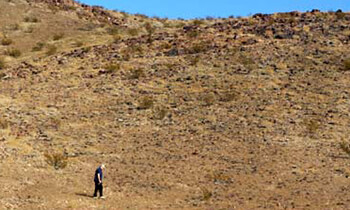Crow Canyon Archaeological Center
Digging into the Past
by Joe Zentner
Most of America’s national parks protect natural wonders—mountains, forests, lakes, canyons, caves, rivers, seashores or islands. By contrast, the 7000-foot-high Mesa Verde National Park, located in southwestern Colorado, was the very first (1906) designated specifically for preserving manmade creations, marking a watershed moment in the preservation of the cultural treasures of the West.

Built from sandstone early in the second millennium, the park’s well-known cliff dwellings – masterpieces in community planning and architecture – lie at the top of the mesa or in sequestered canyon alcoves. They are every bit as spectacular now as they were when two cowboys, Richard Wetherill and his brother-in-law Charles Mason, discovered Mesa Verde’s famous 150-room Cliff Palace in 1888.
Mesa Verde’s cliff dwellings were built by people of the Puebloan tradition called “Anasazi,” a Navajo word meaning “enemy ancestors.” The Anasazi range encompassed the greater region surrounding the Four Corners, where Colorado, Utah, Arizona and New Mexico meet at a common point.
A Sketch of the Region’s Prehistory
Long before the Anasazi, during the Ice Ages, which ended roughly 10,000 years ago, nomadic bands of hunters in the Four Corners region preyed on the big game animals such as mastodons, wooly mammoths and bison. Called Paleo Indians, they held tenaciously to their culture, changing little over thousands of years.
When the last Ice Age closed and the big game animals died out, the nomadic bands turned increasingly to smaller game, for instance, rabbits and wild fowl, and to wild plants for sustenance, both in the lower desert elevations and in the higher mountain elevations. Called Archaic Indians, they likely, over time, calibrated their movements to the seasonal ripening of the plants rather than the movement of game. By three or four thousand years ago, they may have lived in rudimentary hamlets and practiced elementary agriculture. Most importantly, the Archaic Indians began the revolutionary process of cultural diversification.
By early in the first millennium, the peoples of the Four Corners had changed still more, becoming largely defined by farming, hunting and foraging; pithouse and rock shelter occupations; and splendid plant-fiber baskets, mats and cradles. Called Basketmakers, reflecting their weaving skills, they laid the foundation for the emergence of the Anasazi Puebloans.

The Anasazi, more than any other Puebloans, would become known for community planning, architecture and masonry. Most often the Anasazi built their structures from shaped bricks hewn from sandstone formations. They evidently held community and clan gatherings, ceremonies and ritual in semisubterranean circular structures called “kivas.” They retained the ancestral skill of basketmaking and developed new skills in ceramics and jewelry making. They used tools they made from stone, bone and wood. They traded their crafts widely across the Southwestern deserts and deep into Mexico.
For poorly understood reasons, the Anasazi abandoned much of the Four Corners region in the 12th and 13th centuries, migrating generally eastward and southward. Many settled in the Río Grande’s upper drainage basin. Others evidently drifted southward as far as the northwestern corner of Mexico’s state of Chihuahua. Descendants of the migrant Anasazi greeted the Spaniards when they arrived on the upper Río Grande in the 16th century, and Anasazi descendants still occupy Pueblos such as the Hopi villages of northeastern Arizona and the Acoma and Laguna villages of west-central New Mexico.
At some point, perhaps in the wake of the Anasazi abandonments, hunting and gathering bands of Navajos and Utes asserted dominance over the Four Corners region, where the tribes live to this day. Some Navajos still occupy, at least for part of the year, their traditional east-facing hogans, small circular structures built of logs and plastered with earth.
Origins of American Archaeology
The long record of human occupation in the ruins of Colorado’s Mesa Verde, New Mexico’s Chaco Canyon, Arizona’s Canyon de Chelly, and Utah’s Hovenweep plus thousands of more sites in the Four Corners region gave rise to much of the early archaeology work in the United States. Scientists in an array of fields have for generations tried to answer a multitude of intriguing questions. For example, why did the Mesa Verde Anasazi move their homes from the mesa tops to canyon alcoves? Why did the Chaco Canyon Anasazi build highly elaborate pueblos, which are connected by a complex road system to a broad network of Anasazi communities? What attracted restless Anasazi from distant areas to Canyon de Chelly late in the Anasazi occupation of the region? Why did the Hovenweep Anasazi, who were closely related to the Mesa Verde Anasazi, build distinctive towers at their pueblo villages? Why did the Anasazi abandon the Four Corners region? Was it drought? Exhaustion of resources? The onset of disease? The threat of attack? The loss of faith in the political and religious leadership? The appeal of a distant, new political and religious leadership?

Crow Canyon Archaeological Center
For the past quarter century, the Crow Canyon Archaeological Center, located in the heart of Anasazi country, near Cortez, Colorado, and about 10 miles northwest of Mesa Verde National Park, has conducted archaeological research and public education in partnership with Native American scholars and academic institutions. The Center is a not-for-profit organization that has developed a variety of quality educational programs.
The Center’s programs for public participants include activities such as supervised excavations, cleaning and sorting artifacts, archaeological laboratory work and, with guidance from professional archaeologists, artifact interpretation. Much of the excavation is centered at Shields Pueblo, a large village that was occupied between approximately 600 and 1300 AD. No experience is required to learn about America’s complex prehistory, to excavate alongside professional archaeologists, and to join a nationally recognized research team.
Crow Canyon archaeological experiences vary from half-day trips in June, July and August to full week adventures. Activities range from visits to excavation sites and archaeological laboratories to intensive supervised excavation and fieldwork to learning programs with Native American scholars. Visitors have the opportunity to explore, camp, hiking and raft. The Center also offers cultural exploration programs in Egypt, Mesoamerica (the great city states of southern Mexico) and many other areas throughout the world.
Crow Canyon programs begin with an introduction to the prehistory of the Southwest and archaeologist-led tours of the area. A day of work in an archaeological laboratory is followed by two days of excavation under the tutelage of professionals. The programs offer a good balance of learning activities that involve family members of all age groups.
Near Crow Canyon
The Anasazi Heritage Center (AHC), Dolores, Colorado, is a Bureau of Land Management museum that provides interpretations of the history and culture of the Canyons of the Ancients National Monument, the Trail of the Ancients, and the Four Corners region.
In June of 2000, the AHC became the information headquarters for Canyons of the Ancients National Monument. Brochures and information about the monument are available at the museum’s front desk. Four areas are minimally developed for public viewing in the Monument. They are Lowry Pueblo, Painted Hand Pueblo, Sand Canyon Pueblo and the Sand Canyon Trail. These areas are accessible by dirt and gravel county roads.
The pueblo-style AHC museum opened to the public in 1988. Its staff manages over three million artifacts. Most of them represent the Northern San Juan branch of the Anasazi culture. A primary goal of the AHC is to increase public awareness of the area’s archaeology and cultural resources, the ancestral Puebloan culture, and wise multiple-use management of public lands.

Exhibits interpret these themes through artifact displays and illustrations, a pithouse replica, and interactive computer programs. “Hands-on” exhibits demonstrate traditional weaving and corn grinding activities as well as tree-ring dating.
An AHC special exhibit – Archaeology Grows Up – runs through October 7, 2007. This exhibit covers the transformation of archaeology from the era of the 1906 Antiquities Act to the modern, computer-assisted study of ancient peoples. Spectacular artifacts and historic images make this a must-see show.
For more information, contact:
Anasazi Heritage Center
Canyons of the Ancients National Monument
27501 Highway 184
Dolores, Colorado 81323
Phone 1-970-882-5600
The museum is open daily from 9 am to 5 pm (March-Oct.), and 10 am to 4 pm (November-February).
The Cortez Cultural Center is located in a building constructed in 1909 to house the E. R. Lamb Mercantile Store. The Center, founded in 1987, is a non-profit organization with the mission of providing educational, cultural and artistic programs. It has become a home for artists, cowboy poets, archaeologists and musicians. Since its inception, the Center has provided programs to thousands of residents and visitors to the Four Corners area.
Local and national performers, including Native American dancers, appear at the Center throughout the year. It is open Monday through Saturday, June through August, 10:00 a.m. to 10:00 p.m., and September through May, 10:00 a.m. to 5:00 p.m. The museum has interpretive exhibits on basketmakers, as well as modern-day Pueblo, Ute and Navajo tribes.
For more information, contact:
Cortez Cultural Center
25 North Market
Cortez, Colorado 81321
Phone 1-970-565-1151
Besides being a gateway to the Four Corners region and a good base for exploring prehistoric sites, the community of Cortez is a mecca for American Indian art. The area prides itself on its many knowledgeable art dealers whose understanding of native art is based on years of experience handed down through generations. Several art galleries and trading posts are dedicated to Indian artistry. Browsers will find a vast selection of arts from area tribes and pueblos. In addition, Cortez is one of only a few locations where shoppers will find a gallery dedicated specifically to Navajo folk art.
If You Go
Crow Canyon’s 110-acre campus provides abundant space for relaxing, observing wildlife, hiking juniper-covered hillsides, and enjoying panoramic mountain views from rocking chairs located on the Center’s deck. Shared living accommodations are provided in cabins built in the style of Navajo hogans. Families are housed together. Shared shower and restroom facilities are located adjacent to the cabins. Bring your own bedding and towels.
The archaeological fieldwork will require hiking up to a quarter of a mile, hauling buckets of dirt, kneeling on rocky ground, and working at high altitudes. You can proceed at your own pace, but the experience will be much more enjoyable if you’re in good physical shape.
Keep in mind that archaeological sites are irreplaceable links to history. To preserve this legacy for future generations:
- Avoid stepping on walls and trash mounds.
- Never touch painted or plastered walls, pictographs or petroglyphs. Skin oil from human hands can damage ancient artwork.
- Leave artifacts exactly where they are found. Out of context, artifacts mean little to archaeologists.
- Stay on existing trails. Scars on the desert landscape heal slowly, if at all, and accelerate soil erosion.
- Do not leave modern “offerings” at any archaeological site. They only muddle its original story.
- When hiking, carry a map, water, food and first aid kit. Do not travel alone.
- Wear a hat, long-sleeved shirt, long pants and sturdy footwear.
- Watch out for rattlesnakes, scorpions, mountain lions and other potentially dangerous wildlife.
For more information, contact
Crow Canyon Archaeological Center
23390 Road K
Cortez, Colorado 81321-9408
Phone 1-970-565-8975 or
Toll Free 1-800-422-8975
More...
Share this page on Facebook:
The Desert Environment
The North American Deserts
Desert Geological Terms







